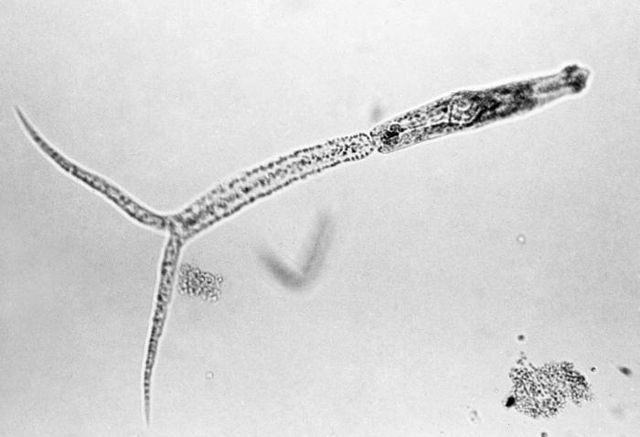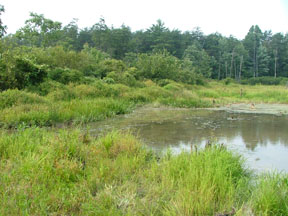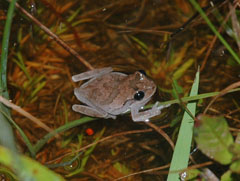

Rohr Laboratory of Ecology and Public Health
| Ecotoxicology |
||
Summer field work Chemical pollution
Pinewoods treefrog (Hyla femoralis)
|
Research and Publications |
|
Pollution is considered the second greatest threat to aquatic and amphibious species (behind habitat loss) in the United States (Wilcove and Master 2005), and yet it ranked second to last out of nine threats to biodiversity in the level of research effort (Lawler et al. 2006). Consequently, we know very little about the impact pollution has on biodiversity relative to other threats. Further, pesticide use has been correlated with amphibian population declines (Davidson et al. 2001, 2002), suggesting that pollution might be an important factor in the declines of one of the most threatened taxa in the world. We are making an effort to redress this gap between the threat that pollution poses and the scientific effort dedicated toward understanding the effects of pollution on biodiversity. Here are some of the questions in which we are interested:
Sample Publications Staley, Z.R., Harwood, V.J., Rohr, J.R. in press. A synthesis of the effects of pesticides on microbial persistence in aquatic ecosystems. Critical Reviews in Toxicology Rohr, J.R., Farag, A.M., Cadotte, M.W., Clements, W.H., Smith, J.R., Ulrich, C.P., Woods, R. in press. Transforming ecosystems: When, where, and how to restore contaminated sites. Integrated Environmental Assessment and Management Halstead, N.T., Civitello, D.J., Rohr, J.R. 2015. Comparative toxicities of organophosphate and pyrethroid insecticides to aquatic macroarthropods. Chemosphere 135:265-271 Douglas, M.R, Rohr, J.R., Tooker, J.F. 2015. Neonicotinoid insecticide travels through a soil food chain, disrupting biocontrol of non-target pests and decreasing soybean yield. Journal of Applied Ecology 52:25-260 Editor’s Choice, cover photo, and commentary (http://www.journalofappliedecology.org/view/0/editorschoice521.html; Altmetric score of 105, 99th percentile and top 10 ever for the journal as of 6/2015) Staley, Z.R., Senkbeil, J.K., Rohr, J.R., Harwood, V.J. 2014. Agrochemicals indirectly increase survival of E. coli O157:H7 and indicator bacteria in freshwater by reducing ecosystem services. Ecological Applications 24:1945-1953 Boone, M.D., Bishop, C.A., Boswell, L.A., Brodman, R., Burger, J., Davidson, C., Gochfeld, M., Hoverman, J.T., Neuman-Lee, L., Propper, C.R., Relyea, R.A., Rohr, J.R., Rowe, C.L., Salice, C., Semlitsch, R.D., Sparling, D., Weir, S*. 2014. The influence of industry: how conflicts of interest compromise pesticide regulation. Bioscience 64:917-922 Halstead, N.T., McMahon, T.A., Johnson, S., Raffel, T.R., Romansic, J.M., Crumrine, P.W., Rohr, J.R. 2014. Community ecology theory predicts the effects of agrochemical mixtures on aquatic biodiversity and ecosystem properties. Ecology Letters 17:932-941 Rohr, J.R., Raffel, T.R., Halstead, N.T., McMahon, T.A., Johnson, S.A., Boughton, R.K., Martin, L.B. 2013. Early-life exposure to an herbicide has enduring effects on pathogen-induced mortality. Proceedings of the Royal Society of London B 280:20131502 (Altmetric score of 71) McMahon, T.A., Romansic, J.M., Rohr, J.R. 2013. Non-monotonic and monotonic effects of pesticides on the pathogenic fungus Batrachochytrium dendrobatidis in culture and on tadpoles. Environmental Science and Technology 47:7958-7964 Rohr, J.R., Johnson, P., Hickey, C.W., Helm, R., Fritz, A., Brasfield, S. 2013. Implications of global climate change for natural resource damage assessment, restoration, and rehabilitation. Environmental Toxicology and Chemistry 32: 93-101 McMahon, T.A., Halstead, N.T., Johnson, S., Raffel, T.R., Romansic, J.M., Crumrine, P.W., Rohr, J.R. 2012. Fungicide-induced declines of freshwater biodiversity modify ecosystem functions and services. Ecology Letters 15: 714-722 Rohr, J.R., Halstead, N.T., Raffel, T.R. † 2012. The herbicide atrazine, algae, and snail populations. Environmental Toxicology and Chemistry 31: 973-976 Jennings, D.E., Congelosi, A.M., Rohr, J.R. 2012. Insecticides reduce survival and the expression of traits associated with carnivory of carnivorous plants. Ecotoxicology 21: 569-575 Staley, Z., Rohr, J.R., Harwood, V.J. 2011. A test of direct and indirect effects of agrochemicals on the survival of fecal indicator bacteria. Applied and Environmental Microbiology 77: 8765-8774 McMahon, T., Crumrine, P., Halstead, N., Johnson, S., Raffel, T.R., Romansic, J., Rohr, J.R. 2011. Chlorothalonil: a deadly, immunomodulatory, and corticosterone-inducing fungicide to amphibians. Environmental Health Perspectives. 119: 1098-1103 Rohr, J.R., Sesterhenn, T., Stieha, C. 2011. Will climate change reduce the effects of a pesticide on amphibians?: Partitioning effects on exposure and susceptibility to pollution. Global Change Biology. 17: 657-666 Staley, Z., Rohr, J.R., Harwood, V.J. 2010. The effect of agrochemicals on indicator bacteria densities in outdoor mesocosms. Environmental Microbiology. 12: 3150-3158 Rohr, J.R., McCoy, K.A. 2010. Preserving environmental health and scientific credibility: A practical guide to reducing conflicts of interest. Conservation Letters. 3: 143-150 Martin, L.B., Hopkins, W.A., Mydlarz, L.D., Rohr, J.R. 2010. The effects of anthropogenic global change on immune functions and disease resistance. Annals of the New York Academy of Sciences: The Year in Ecology and Conservation Biology. 1195: 129-148 Rohr, J.R., McCoy, K.A. 2010. A qualitative meta-analysis reveals consistent effects of atrazine on freshwater fish and amphibians. Environmental Health Perspectives. 118: 20-32 Raffel, T.R., Sheingold, J.L., Rohr, J.R. 2009. Lack of pesticide toxicity to Echinostoma trivolvis eggs and miracidia. Journal of Parasitology. 95: 1548-1551 Clements, W.H., Rohr, J.R. 2009. Community responses to contaminants: Using basic ecological principles to predict ecotoxicological effects. Environmental Toxicology and Chemistry. 28: 1789-1800 Rohr, J.R., Schoetthofer, A.M., Raffel, T.R., Carrick, H.J., Halstead, N., Hoverman, J.T., Johnson, C.M., Johnson, L.B., Lieske, C., Piwoni, M.D., Schoff, P.K., Beasley, V.R. 2008. Agrochemicals increase trematode infections in a declining amphibian species. Nature. 455: 1235-1239 Rohr, J.R., Raffel, T.R., Sessions, S.K., Hudson, P.J. 2008. Understanding the net effects of pesticides on amphibian trematode infections. Ecological Applications. 18: 1743-1753 Leslie, T.W., Hoheisel, G.A., Biddinger, D.J., Rohr, J.R., Fleischer, S.J. 2007. Transgenes sustain epigeal biodiversity in diversified vegetable farm systems. Environmental Entomology. 36: 234-244 Rohr, J.R., Kerby, J., Sih, A. 2006. Community ecology theory as a framework for predicting contaminant effects. Trends in Ecology and Evolution. 21: 606-613 Rohr, J.R., Sager, T. Sesterhenn, T., Palmer, B.D. 2006. Exposure, post-exposure, and density-mediated effects of atrazine on amphibians: Breaking down net effects into their parts. Environmental Health Perspectives. 114: 46-50 Rohr, J.R., Crumrine, P. 2005. Effects of an herbicide and an insecticide on pond community structure and processes. Ecological Applications. 15:1135-1147 Rohr, J.R., Palmer, B.D. 2005. Aquatic herbicide exposure increases salamander desiccation risk eight months later in a terrestrial environment. Environmental Toxicology and Chemistry. 24:1253-1258 Rohr, J.R., Elskus, A.A., Shepherd, B.S., Crowley, P.H., McCarthy, T.M., Niedzwiecki, J.H., Sager, T., Sih, A., Palmer, B.D. 2004. Multiple stressors and salamanders: Effects of an herbicide, food limitation, and hydroperiod. Ecological Applications. 14:1028-1040 Rohr, J.R., Elskus, A.A., Shepherd, B.S., Crowley, P.H., McCarthy, T.M., Niedzwiecki, J.H., Sager, T., Sih, A., Palmer, B.D. 2003. The lethal and sublethal effects of atrazine, carbaryl, endosulfan, and octylphenol on the streamside salamander, Ambystoma barbouri. Environmental Toxicology and Chemistry. 22:2385-2392 Rohr, J.R., Kerby, J.L., Sesterhenn, T., Sih, A. in prep. Evidence that trait-mediated effects of pollution can cause population declines. For a full list of publications, please see the Publications page on this website. |
||


